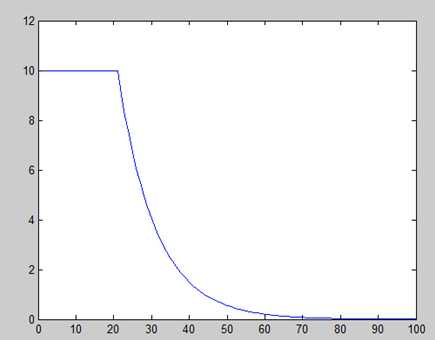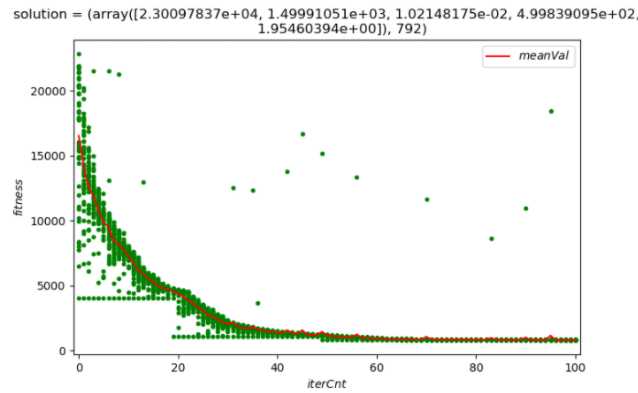具体方案如下所示:
根据这个地图,我们构建1010矩阵,大概草图如下所示:
然后,根据之前的设计要求,我们假设浇筑满的时间为t1~tN。
然后浇筑的速度随着时间的变换而逐渐变小,假设其流速的函数为
然后是浇筑的位置假设为(x,y)
那么,实际浇筑的问题,可以转换为如下的数学模型:
即,通过优化选择最优的位置x和y,以及控制胶水浇筑的流速,使得填满整个白色区域的时间最小,且不溢出。
根据这些信息,我们构建如下的具体模型:
未知变量有A,即图中10,
tstep,图中为20
缓慢降低指数,k,图中为0.1.
先运行main.py,这个是上述优化算法的优化过程,因为图片上可以优化的情况又数百万种情况,所以仿真速度较慢,大概1个小时后,会得到如下结果:
运行后,得到参数
以及浇筑位置:
得到实际的浇筑效果

达到了预期的效果,即一开始较快,然后在到细通道的时候,逐渐变慢。
部分python代码如下所示:
import numpy
import matplotlib.pyplot as plt
import math
import random
import matplotlib.pyplot as plt
import matplotlib.image as mpimg # mpimg 用于读取图片
import cv2
import numpy as np
from utiles import *
from PIL import Image
global h
global obstacles
global S
global h
global Xcan
global Ycan
global row
global col
# 目标函数2
# def bestAB_models(x1, x2, x3, x4, x5):
# return abs(x1+x2+x3+x4+x5)
def bestAB_models(x1, x2, x3, x4, x5):
idx = math.floor(x1);
x = round(Xcan[idx]);
y = round(Ycan[idx]);
A = x2;
k = x3;
tstep = x4;
B = x5;
Times = 1000;
g = np.zeros((1, Times));
for i in range(0, Times):
if i <= tstep:
g[0, i] = A
if i > tstep:
g[0, i] = (A – B) * np.exp(-1 * k * (i – tstep)) + B;
S0 = h * S;
rest = 1;
tt = 0;
ks = 0.0005/50;
V = 0;
flag = np.zeros((1,40000));
while (rest>0):
tt=tt+1
W, L = funcW(obstacles, x, y, row, col)
if tt<=Times:
gt=g[0, tt-1];
else:
gt=40;
HS = gt * ks / min(W, L);
if (HS>h) | (W<90|L<20):#溢出
flag[0,tt-1] = 1;
else:
flag[0,tt-1] = 0;
S0 = S0 – gt;
rest = S0;
if (sum(sum(flag))>0):
tt=10000000000
return tt
# 遗传算法: 选择, 交叉, 变异
class GA(object):
def __init__(self, func, lbounds, ubounds, population_size=100, maxIter=500, pm=0.001, speed=3, cf=0.999):
self.func = func # 目标函数
self.lbounds = lbounds # 搜寻下界
self.ubounds = ubounds # 搜寻上界
self.population_size = population_size # 种群规模
self.maxIter = maxIter # 最大迭代次数
self.pm = pm # 变异概率(0, 1)
self.speed = speed # 种群收敛速度[1, +∞)
self.cf = cf # 交叉因子(0, 1)
self.size = len(lbounds) # 搜索空间的维度
self.best_chrom_fitness = list() # 最优染色体(染色体, 适应度)迭代记录列表
self.__record_fitness = list() # 种群适应度迭代记录列表
def solve(self):
# 种群随机初始化
population = self.__init_population()
# 记录种群最优染色体信息
self.__add_best(population)
for i in range(self.maxIter):
print(i)
# 种群更新
population = self.__selection(population)
population = self.__crossover(population)
population = self.__mutation(population)
# 上一代最优个体无条件保留至下一代
population[0] = self.best_chrom_fitness[-1][0]
# 记录种群最优个体
self.__add_best(population)
self.solution = self.best_chrom_fitness[-1]
# 选择: 轮盘赌方法
def __selection(self, population):
# 适应度排序
fitness = self.__cal_fitness(population)
new_fitness = sorted(list((ele, idx) for idx, ele in enumerate(fitness)), key=lambda item: item[0],
reverse=True)
# 轮盘区间计算 -> 采用多项式函数对收敛速度进行调整
roulette_interval = self.__cal_interval()
# 随机飞镖排序
random_dart = sorted(numpy.random.random(self.population_size))
new_population = list()
idx_interval = idx_dart = 0
while idx_dart < self.population_size:
if random_dart[idx_dart] > roulette_interval[idx_interval]:
idx_interval += 1
else:
new_population.append(population[new_fitness[idx_interval][1]])
idx_dart += 1
# 顺序打乱
numpy.random.shuffle(new_population)
return new_population
# 交叉: 对称凸组合
def __crossover(self, population):
# 交叉随机数 -> 采用交叉因子提高计算精度
alpha = numpy.random.random(self.population_size – 1) * self.cf
for idx in range(self.population_size – 1):
new_chrom1 = alpha[idx] * population[idx] + (1 – alpha[idx]) * population[idx + 1]
new_chrom2 = alpha[idx] * population[idx + 1] + (1 – alpha[idx]) * population[idx]
population[idx] = new_chrom1
population[idx + 1] = new_chrom2
return population
# 变异: 全空间变异
def __mutation(self, population):
# 变异概率随机数
mutation_prob = numpy.random.random(self.population_size)
for idx, prob in enumerate(mutation_prob):
if prob <= self.pm:
# 变异幅度随机数
mutation_amplitude = numpy.random.uniform(-1, 1, self.size)
for idx_dim, ampli in enumerate(mutation_amplitude):
if ampli >= 0: # 正向变异
population[idx][idx_dim] += ampli * (self.ubounds[idx_dim] – population[idx][idx_dim])
else: # 负向变异
population[idx][idx_dim] += ampli * (population[idx][idx_dim] – self.lbounds[idx_dim])
return population
# 种群随机初始化
def __init_population(self):
population = list()
for i in range(self.population_size):
chrom = list()
for j in range(self.size):
chrom.append(numpy.random.uniform(self.lbounds[j], self.ubounds[j]))
population.append(numpy.array(chrom))
return population
# 种群适应度计算
def __cal_fitness(self, population):
fitness = list(self.func(*chrom) for chrom in population)
return fitness
# 记录种群最优染色体信息
def __add_best(self, population):
fitness = self.__cal_fitness(population)
self.__record_fitness.append(fitness)
min_idx = numpy.argmin(fitness)
self.best_chrom_fitness.append((population[min_idx], fitness[min_idx]))
# 轮盘区间计算
def __cal_interval(self, speed=2):
tmp = (numpy.arange(self.population_size) + 1) / self.population_size
tmp_normalize = tmp / (self.population_size + 1) * 2
roulette_interval = list()
curr_sum = 0
for item in tmp_normalize:
curr_sum += item
roulette_interval.append(curr_sum)
roulette_interval = numpy.array(roulette_interval) ** self.speed
return roulette_interval
# 求解过程可视化展示
def display(self):
fig = plt.figure(figsize=(8, 5))
axes = plt.subplot()
axes.plot(self.__record_fitness, ‘g.’)
axes.plot(numpy.array(self.__record_fitness).sum(axis=1) / self.population_size, ‘r-‘, label=’$meanVal$’)
axes.set(xlim=(-1, self.maxIter + 1), xlabel=’$iterCnt$’, ylabel=’$fitness$’)
axes.set(title=’solution = {}’.format(self.solution))
axes.legend()
fig.savefig(‘myGA.png’, dpi=500)
plt.show()
plt.close()
if __name__ == ‘__main__’:
#读取地图,读取地图的参数信息
map = mpimg.imread(‘map.jpg’)
obstacles = cv2.cvtColor(map, cv2.COLOR_BGR2GRAY)
obstacles2 = obstacles;
h = 30;#假设高度
map.shape
row = map.shape[0]
col = map.shape[1]
KK = map.shape[2]
#计算空白区域面积
S = 0;
for i in range(0, row): # 遍历所有长度的点
for j in range(0, col): # 遍历所有宽度的点
if obstacles2[i, j] > 100:
obstacles[i, j] = 1
S = S+1;
else:
obstacles[i, j] = 0
Xcan, Ycan = findm(obstacles, row, col)
# x = round(Xcan[idx]);
# y = round(Ycan[idx]);
# A = x2;
# k = x3;
# tstep = x4;
# B = x5;
#五个参数含义,第一个就是浇筑大概范围,别太大,否则搜索会错误,第二个到第五个就是我g里面的四个参数
ins = GA(bestAB_models, [23000, 100,0.01,1,0], [23600, 1500,0.05,500,50], population_size=50, maxIter=100, pm=0.005, speed=1, cf=0.95)
ins.solve();
ins.display();
A43-006
今天的文章使用python实现智能浇筑方案分享到此就结束了,感谢您的阅读,如果确实帮到您,您可以动动手指转发给其他人。
版权声明:本文内容由互联网用户自发贡献,该文观点仅代表作者本人。本站仅提供信息存储空间服务,不拥有所有权,不承担相关法律责任。如发现本站有涉嫌侵权/违法违规的内容, 请发送邮件至 举报,一经查实,本站将立刻删除。
如需转载请保留出处:https://bianchenghao.cn/33145.html










